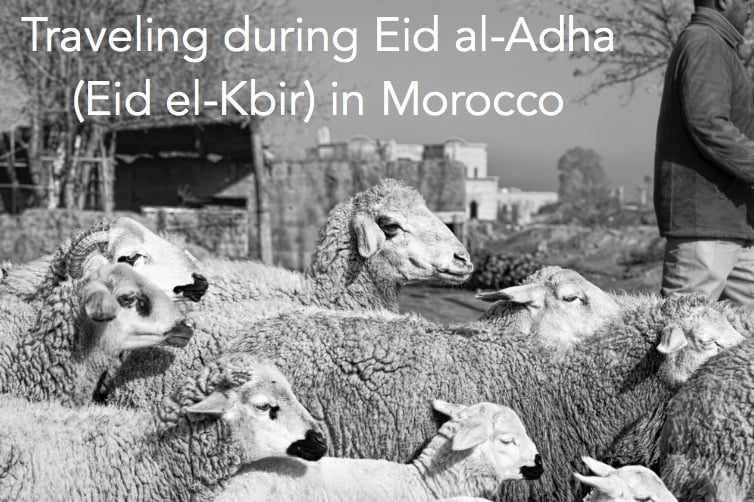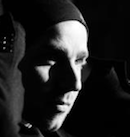
By far, Eid al-Adha is the most important holiday for Muslims around the world. It occurs two lunar months after the end of Ramadan. Confusingly, Eid al-Adha called by many different names. Eid el-Kbir (often spelled “Eid el-Kbeer, “Aid al-Kébir” and other variations) is really common. It translates to “The Big Holiday”. With francophiles, la fête du mouton (“sheep festival”) is also common.
Why is Eid al-Adha (Eid el-Kbir) Important?
In Islam, Eid al-Adha marks the willingness of Abraham to sacrifice his son, Ismael, to God. This is similar to the story of Abraham in the Old Testament. However, in the Old Testament it is Isaac who is offered as a sacrifice. Though In practice, Eid al-Adha today functions something more like a multi-day Thanksgiving… with lots of eating!
What is Eid al-Adha Like?
In the days leading up to Eid al-Adha, sheep are everywhere. They graze in the fields and in your neighbor’s backyard. Pickups trucks crowd them into their beds. Fathers tie them to the handles of their scooters. From the rooftops and balconies they bleat out. And down on the street, ride their family sheep like a horse or lead it around like a dog.

The slaughter of the sheep marks the first day of Eid al-Adha. Thus the references to it as the “sheep festival.” This day is not for the feint of heart. Butchers roam the street, entering homes with their long knives and blood-splattered aprons. They go door-to-door to make a halal slaughter of every sheep in the neighborhood. Later in the afternoon, sheep heads are burned in outdoor barrels, found on nearly every street corner. The stench of burning wool and charred meat fills the air.
This is a customary practice. Over the course of Eid al-Adha, practically every square inch of the sheep is used.
At home, traditionally the women clean the slaughtered animal. After cleaning, special dishes for the holiday are made using the different pieces of the sheep and spice blends. These dishes are usually made only once or twice a year, whenever there is an occasion to slaughter a sheep. It’s normal practice for families to give 1/3 of their sheep as a form of charity to poorer families.

The Special Meals for Each Day of Eid al-Adha
Day 1: The first meal of Eid al-Adha is kebda charmoula and/or boul fev. These dishes use a particular layer of fat from the sheep found around the stomach. First, the meat is spiced with paprika, cumin, garlic, parsley and coriander and then grilled. Later that night, laa’lawa or kersha, each of which use the organs and intestines, is made. These are little morsels spiced like the kebda charmoula.
Day 2: A giant couscous is served for a big lunch. The head of the sheep and/or feet are generally buried in the couscous. The cheeks and eyes of the sheep are considered delicacies. For dinner, the kidneys, and sometimes the testicles, are used to make a light soup (shorba) with onion and vermicelli.
Day 3: Most Moroccans love mhammar, a special preparation of lamb chops. First, they are coated in smen (rancid butter). Next, they are marinated with cumin, turmeric, coriander grains, garlic, olive oil, salt, and pepper. Finally, they are seared in olive oil and smen, boiled and baked. Another special dish made on the third day is mrrozeya. This is a particular tajine made from neck of the sheep. The meat is slow cooked with ras-al-hanoot, ginger, pepper, turmeric, garlic and onion. Before the meat is done, honey or sugar is added alongside with raisins and almonds.
The Pros and Cons of Traveling Morocco During Eid al-Adha
The Pros:
Eid al-Adha is one of the most joyous, rambunctious, family-friendly times to visit Morocco. It’s easy to understand why they call it Eid el-Kbir, “The Big Holiday.” Every meal is a lavish, mouthwatering affair. Families reunite after a long year of separation, friends come together to celebrate, and everywhere you look there is some raucous celebration afoot. If you’re lucky enough to spend Eid al-Adha with a family, even if it’s only for one meal, it will be an unforgettable experience and a memory you’ll cherish for a lifetime.
Because so many Moroccans spend the holidays back home with the family, Eid al-Adha can be a blessing for those looking to get away from the crowds. This is an opportune time to visit otherwise crowded beaches, national parks and nature reserves.
The Cons:
Expect all modes of transportation to be congested and traffic to be at a standstill just before and just after the holiday. Because families move back and forth across the country, they clog the motorways and train cars. During the holiday, nearly everything is shutdown, including most city buses. Taxi drivers are a scarce commodity.
If you’re not staying with a family or going somewhere more secluded, it’s usually best to stick to metropolitan cities, such as Casablanca, Fez, Marrakesh, Rabat or Tangier. In cities you’ll have the best opportunity to find restaurants and hotels open and that cater to travelers.
Generally speaking, Eid el-Kbir is a time of great joy. Families and friends come together, often from out of the country. Smiling faces are everywhere. And for travelers, it is an exciting time to glimpse into a special time of year, to take part in the ambiance of the more traditional cultural aspects of Morocco, and to come away with an incredible experience.
Upcoming Dates for Eid al-Adha
Morocco uses an actual physical sighting of the moon to determine their lunar calendar, thus the following dates may change by 1-2 days.
- 2024: June 16-20
- 2025: June 6-10
- 2026: May 27 – June 1
 Text and photos by award-winning writer, photographer, and Morocco expert, Lucas Peters After spending years traveling to the distant corners of Morocco and writing about his adventures, he authored and is the principle photographer of the best-selling guidebook Moon Morocco as well as Marrakesh and Beyond. and Grand European Journeys. He lives in Tangier with his family and is the owner and director of Journey Beyond Travel.
Text and photos by award-winning writer, photographer, and Morocco expert, Lucas Peters After spending years traveling to the distant corners of Morocco and writing about his adventures, he authored and is the principle photographer of the best-selling guidebook Moon Morocco as well as Marrakesh and Beyond. and Grand European Journeys. He lives in Tangier with his family and is the owner and director of Journey Beyond Travel.














